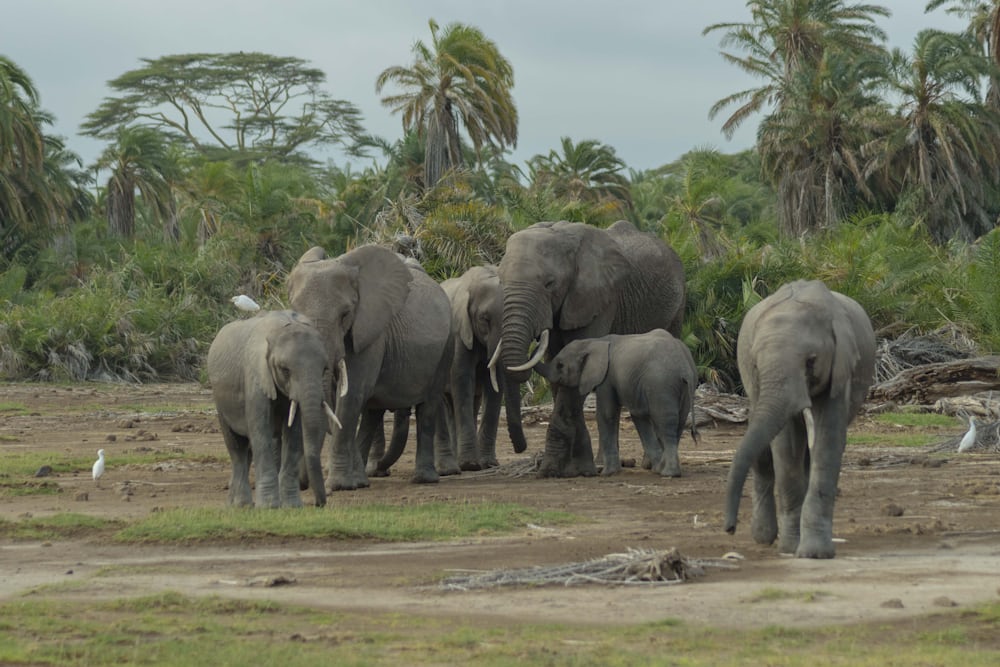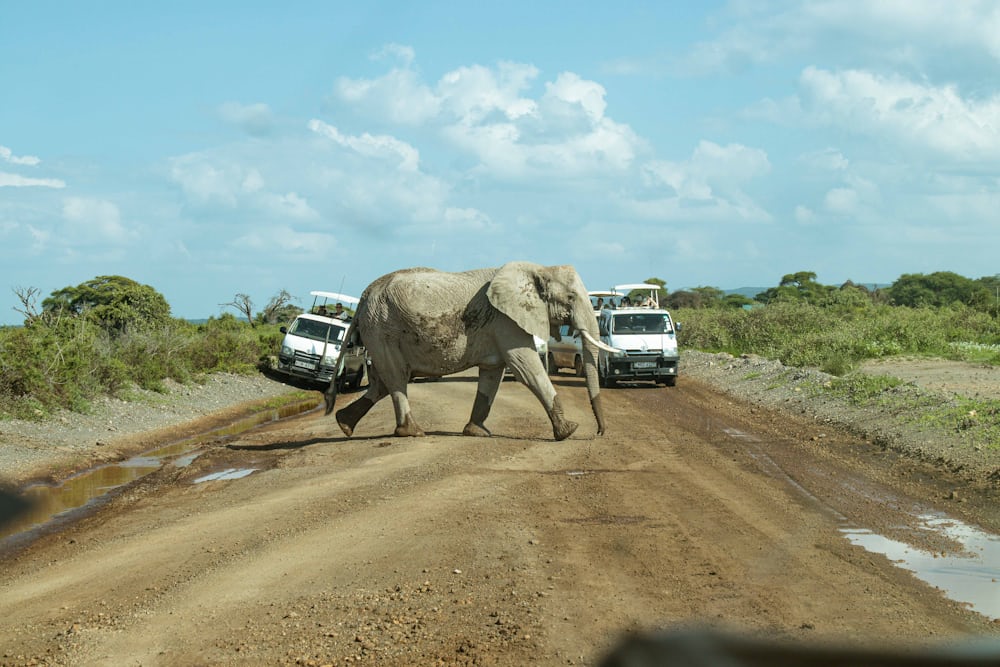Kenya’s natural beauty is epitomized in its diverse landscapes and rich wildlife. Among its renowned national parks, Amboseli National Park stands out as a beacon of conservation, history, and economic significance. Spanning over 392 square kilometers, Amboseli is not only Kenya’s largest national park but also a testament to the country’s commitment to preserving its natural heritage.
Historical Significance.


Amboseli National Park has a rich history dating back centuries. Historically, the area was inhabited by the Maasai people, who coexisted with the wildlife in a harmonious manner. Their traditional lifestyle, characterized by semi-nomadic pastoralism, has left a lasting imprint on the region’s culture and identity. The park’s name “Amboseli” is derived from the Maasai word meaning “salty dust,” a reference to the dry lake bed that dominates the area during the dry season.During the colonial era, Amboseli served as a hunting reserve for British colonialists. However, in 1974, it was officially designated as a national park, primarily to protect its unique ecosystem and diverse wildlife.
Economic Contribution.
Amboseli National Park plays a crucial role in Kenya’s economy, particularly in the tourism sector. Each year, thousands of visitors flock to Amboseli to witness its breathtaking landscapes and iconic wildlife, generating significant revenue for the country. Tourism activities such as game drives, guided walks, and cultural visits provide employment opportunities for local communities, thereby contributing to livelihoods and economic development in the region.Moreover, Amboseli’s proximity to other popular tourist destinations, such as Mount Kilimanjaro and Tsavo National Park, further enhances its appeal and economic value to Kenya’s tourism industry.
Management and Conservation Efforts.
The management of Amboseli National Park is overseen by the Kenya Wildlife Service (KWS), the government agency responsible for wildlife conservation and management in the country. KWS works tirelessly to protect Amboseli’s diverse ecosystems and wildlife populations through various conservation initiatives.One of the key conservation challenges facing Amboseli is human-wildlife conflict, particularly between the resident Maasai communities and wildlife such as elephants. KWS collaborates with local communities to implement measures aimed at mitigating these conflicts, including the construction of predator-proof bomas (livestock enclosures) and the provision of compensation for crop and livestock losses.Additionally, KWS conducts research and monitoring programs to better understand Amboseli’s ecosystems and wildlife populations, enabling informed decision-making and conservation strategies.
Breathtaking Landscapes and Wildlife.
Amboseli National Park is renowned for its stunning landscapes and diverse wildlife. The park is dominated by vast grasslands, acacia woodlands, and seasonal swamps, providing habitat for a wide array of species.One of Amboseli’s most iconic features is the backdrop of Mount Kilimanjaro, Africa’s tallest peak, which towers over the park’s plains, creating a picturesque setting that attracts photographers and nature enthusiasts from around the world.Amboseli is also home to a rich diversity of wildlife, including large herds of elephants, buffalo, zebra, wildebeest, giraffe, and various antelope species. Predators such as lions, cheetahs, leopards, and hyenas are also present, offering visitors the opportunity to witness thrilling wildlife interactions.
Cultural Heritage.
In addition to its natural wonders, Amboseli National Park boasts a rich cultural heritage. The Maasai people, who have inhabited the region for centuries, continue to maintain their traditional way of life, characterized by pastoralism and a deep connection to the land and wildlife.Visitors to Amboseli have the opportunity to engage with Maasai communities through cultural visits and interactions, gaining insights into their customs, traditions, and indigenous knowledge systems. These cultural experiences not only enrich the visitor’s understanding of the region but also provide valuable support to local communities through tourism revenue.Amboseli National Park stands as a shining example of Kenya’s commitment to conservation, sustainable tourism, and cultural preservation. Its historical significance, economic contribution, management efforts, breathtaking landscapes, and diverse wildlife make it a must-visit destination for travelers seeking an authentic African safari experience.As Amboseli continues to thrive as a haven for wildlife and a beacon of conservation excellence, it serves as a source of pride for Kenya and a testament to the importance of protecting our natural heritage for future generations to enjoy.
Maasai Influence and Traditional Practices.
Beyond the surface, the Maasai influence on Amboseli National Park runs deep. Their traditional practices, such as livestock herding and communal land management, have shaped the landscape and fostered a unique coexistence with wildlife. Despite modernization and encroaching development, the Maasai’s cultural identity remains intertwined with the park’s ecosystem. Their intimate knowledge of the land, passed down through generations, contributes to the conservation efforts and sustainable management of Amboseli.
Ethnobotanical Knowledge.
Embedded within Maasai culture is a wealth of ethnobotanical knowledge. The Maasai have long relied on indigenous plants for food, medicine, and ritual purposes, forming a symbiotic relationship with the natural world. Within Amboseli National Park, this traditional knowledge continues to thrive, offering insights into the medicinal properties of native flora and their ecological significance. By preserving this ethnobotanical heritage, Amboseli not only conserves biodiversity but also honors the cultural legacy of the Maasai people.
Indigenous Conservation Practices.
The Maasai’s traditional conservation practices extend beyond livestock management to include methods for preserving wildlife habitats and managing natural resources. Through controlled burns, rotational grazing, and seasonal migration patterns, the Maasai have maintained the ecological balance of Amboseli’s grasslands for centuries.These indigenous conservation practices, rooted in a deep respect for nature, complement modern conservation efforts and contribute to the park’s ecological resilience.Interconnectedness of SpeciesAmboseli National Park is a complex ecosystem where every species plays a vital role in maintaining balance and harmony. The interconnectedness of wildlife, vegetation, and natural processes underscores the importance of holistic conservation approaches. Elephants, for example, serve as ecosystem engineers, shaping the landscape through their browsing and seed dispersal activities. Their presence not only influences vegetation dynamics but also creates habitats for other species, demonstrating the intricate web of life within Amboseli.
Threats and Challenges.
Despite its natural beauty and cultural significance, Amboseli National Park faces numerous threats and challenges. Human-wildlife conflict, driven by competition for resources and habitat encroachment, poses a significant risk to both wildlife and local communities. Additionally, poaching, habitat degradation, and climate change further exacerbate the pressures on Amboseli’s delicate ecosystem. Addressing these challenges requires a multi-faceted approach that integrates community engagement, sustainable development, and innovative conservation strategies.
Conservation Innovations.
In response to these challenges, Amboseli National Park has embraced conservation innovations to safeguard its biodiversity and promote sustainable development. Collaborative initiatives between government agencies, non-profit organizations, and local communities have yielded promising results, including the adoption of eco-friendly tourism practices, the implementation of community-based conservation programs, and the introduction of alternative livelihood opportunities. These conservation innovations not only protect Amboseli’s natural heritage but also empower communities to become stewards of their own environment.
Future Prospects.
Looking ahead, the future of Amboseli National Park depends on collective efforts to address conservation challenges while fostering sustainable development and cultural preservation. By leveraging the synergies between traditional knowledge and modern conservation science, Amboseli can continue to thrive as a model of integrated conservation and community resilience. Through collaboration, innovation, and a commitment to safeguarding Kenya’s natural and cultural heritage, Amboseli National Park will remain a beacon of hope for future generations to cherish and enjoy.

